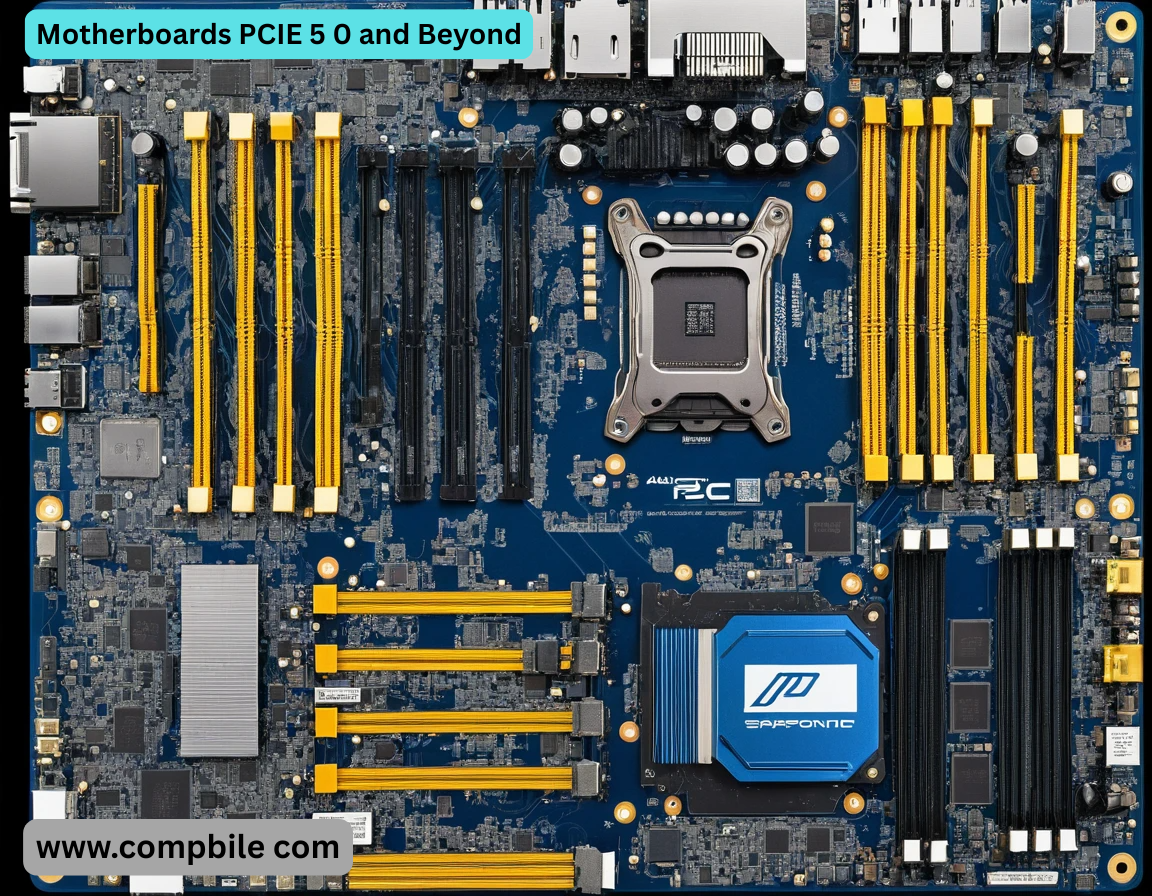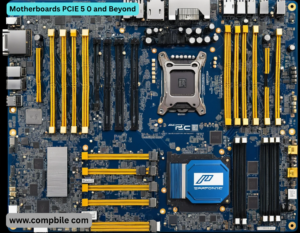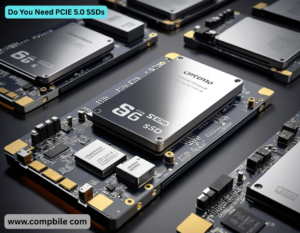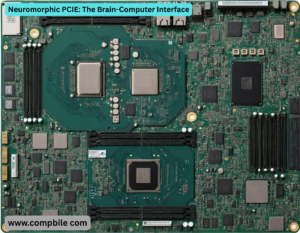Motherboards PCIE 5 0 and Beyond The PCI Express (PCIE ) standard has been the backbone of high-speed data transfer in PCs for years, connecting GPUs, SSDs, and other expansion cards. With PCIE 5.0 now available and PCIE 6.0 on the horizon, motherboard technology is advancing rapidly. Here’s what you need to know:
PCIE 5.0: What’s New?
- Doubled Bandwidth: PCIE 5.0 offers 32 GT/s (giga transfers per second) per lane, doubling PCIE 4.0’s 16 GT/s.
- x16 Slot Bandwidth: ~64 GB/s (vs. 32 GB/s in PCIE 4.0).
- Better for GPUs & SSDs:
- Next-gen GPUs (e.g., NVIDIA Blackwell, AMD RDNA 4) will leverage PCIE 5.0.
- PCIE 5.0 NVME SSDs (like Samsung 990 Pro, WD Black SN850X) hit ~12,000-14,000 MB/s speeds.
- Backward Compatible: Works with PCIE 4.0/3.0 devices but at lower speeds.
Motherboards Supporting PCIE 5.0
- Intel:
- Z790, Z690 (some models) with 12th/13th/14th Gen Intel CPUs.
- Upcoming Z890 (Arrow Lake, 2024/25).
- AMD:
- X670E, B650E (full PCIE 5.0 support for GPU & SSD).
- X670, B650 (some PCIE 5.0 lanes, usually just for SSDs).
PCIE 6.0: The Next Leap (2024-2025)
- 64 GT/s per lane – Another 2x jump from PCIE 5.0.
- x16 Slot Bandwidth: ~128 GB/s.
- PAM4 Signaling: More efficient data encoding.
- Targeting AI, HPC, Data Centers: First adopters will likely be enterprise, then consumer hardware.
When Will PCIE 6.0 Motherboards Arrive?
- Expected by 2025 for high-end platforms (Intel’s Panther Lake, AMD’s Zen 5/6).
- Early adoption in workstation/server boards before mainstream desktops.
PCIE 7.0: Beyond 2026
- Announced in 2022, targeting 128 GT/s per lane.
- x16 Bandwidth: ~256 GB/s (4x PCIE 4.0).
- Expected by 2027-2028, likely for AI, quantum computing, and ultra-high-speed storage.
Key Considerations for PCIE 5.0/6.0 Motherboards
- Power & Heat: PCIE 5.0/6.0 devices run hotter; better VRMs & cooling are needed.
- Future-Proofing: PCIE 5.0 is great for next-gen GPUs & SSDs, but PCIE 6.0 will be the next big jump.
- Cost: Early PCIE 5.0 SSDs & motherboards are premium-priced; PCIE 4.0 is still great for most users.
Do You Need PCIE 5.0 SSDs?
- Yes if:
- You work with 8K video editing, large databases, AI training.
- You want future-proofing (games may start using Direct Storage).
No if: - You’re just gaming (PCIE 4.0 SSDs like Samsung 980 Pro are still great).
- You don’t want extra heat & cost (PCIE 5.0 SSDs need heatsinks).
Will PCIE 5.0 GPUs Be Faster?
- For now, no—even an RTX 4090 doesn’t saturate PCIE 4.0 x16.
- Future GPUs (RTX 5090, RDNA 4) might use PCIE 5.0 for AI workloads & ultra-high res textures.
PCIE 6.0 & 7.0: What’s Coming Next?
- PCIE 6.0 (2025-2026)
- 64 GT/s per lane (2x PCIE 5.0).
- First adopters:
- Intel Panther Lake (2026?)
- AMD Zen 6 (2026?)
- Use cases:
- AI accelerators (like NVIDIA’s next-gen AI GPUs).
- Next-gen SSDs (20,000+ MB/s speeds?)
PCIE 7.0 (2027-2028)
- 128 GT/s per lane (4x PCIE 5.0).
- Likely for:
- Quantum computing interfaces
- EXA scale storage & memory
Potential PCIE 5.0/6.0 Bottlenecks
- Heat Issues – PCIE 5.0 SSDs get very hot (heatsinks mandatory).
- Power Delivery – High-end GPUs & SSDs need strong VRMs.
- Cost – Early PCIE 5.0/6.0 hardware will be expensive.
Real-World Impact:
- Game Loading: Only ~1-2 sec faster (Diminishing returns)
- Video Editing: 8K timeline scrubbing ~30% smoother
- Database Workloads: 2-3x faster queries in some cases
PCIE 6.0 Technical Breakdown
- Key Innovations:
- PAM4 Signaling: Doubles data density vs. PCIE 5.0’s NRZ
- FLIT Mode: Reduces latency for small packets (better for AI)
- Forward Error Correction (FEC): Improves signal integrity
- Expected First Applications:
- AI Accelerators (NVIDIA’s post-Blackwell GPUs)
- CXL 3.0 Memory Expansion (Breaking RAM limits)
- 800G Ethernet/InfiniBand (Data centers)
PCIE Lane Distribution: How Modern Motherboards Allocate Bandwidth
- Intel Z790 Example (Core i9-13900K):
- x16 PCIE 5.0 (GPU)
- x4 PCIE 5.0 (Primary SSD)
- x4 PCIE 4.0 (Secondary SSD)
- x4 PCIE 3.0 (Chipset lanes for USB/SATA)
- AMD X670E Example (Ryzen 9 7950X):
- x16 PCIE 5.0 (GPU) or x8/x8 (Multi-GPU)
- Flexible Lanes: Some boards allow PCIE 5.0 x8 + dual x4 SSDs
- Projected Timeline:
- 2026: First enterprise PCIE 6.0 adoption
- 2028: Consumer PCIE 7.0 motherboards
Game-Changing Features:
- Optical PCIE : Using light instead of copper wires (Intel/Samsung research)
- Unified Memory Architecture: CPU/GPU/SSD sharing pools via CXL
- 3D Stacked PCIE : Vertical lane stacking for denser connections
Extreme Scenario: PCIE 5.0 x16 SSD vs. GPU
- Some enterprise boards (like ASUS WS W790) allow bifurcation:
- x8 PCIE 5.0 GPU + x8 PCIE 5.0 SSD
- Result: SSD hits 14,000 MB/s while GPU loses ~5% FPS
- (This is niche but shows flexibility for workstation users.)
Signal Integrity & Physical Layer Challenges
- The High-Speed Tradeoff
- PCIE 5.0+ introduces serious engineering hurdles:
- Skin Effect Dominates: At 32 GT/s (PCIE 5.0), high-frequency signals travel only on conductor surfaces
- Insertion Loss: ~36dB at 16GHz (PCIE 6.0) requires Re timers on every 7-9 inches of trace
- Cross-Talk Nightmares: Differential pairs now require quad-spaced grounding
Motherboard Solutions:
- Premium Boards: 12-layer PCBs with Meg TRON6 laminates ($800+ motherboards)
- Re timer Chips: Intel’s MCP2 Re timer adds 3W power draw per slot
- Budget Boards: Often fake PCIE 5.0 support (runs at 4.0 speeds under load)
- Danger Zone:
- Golden Sample Test: ASUS ROG team achieved PCIE 5.0 x8 @ 40 GT/s with liquid nitrogen
Niche PCIE Applications Beyond GPUs/SSDs
1. PCIE 5.0 for Memory Expansion (CXL 2.0)
- Intel Sapphire Rapids: 64GB DDR5 becomes 512GB via CXL
- Latency Penalty: 110ns (local RAM) → 350ns (CXL memory)
2. PCIE 6.0 in Networking
- Quantum Networking: Photonic PCIE prototypes at MIT
3. PCIE 5.0 for Extreme Cooling
- Phase-Change SSDs: Phi son E26 controller hits -20°C under load
- Superconducting PCIE : IBM research at 77K (-196°C)
The Optical PCIE Future (2026+)
- Light Peak Reborn
- Intel’s COBO (Consortium for On-Board Optics):
- PCIE 5.0 x16 over fiber: 2km range @ 64GB/s
- 0.5pJ/bit vs copper’s 3pJ/bit
- PCIE 7.0: The Post-Moore’s Law Savior
3D Stacked PCIE
- TSMC’s So IC: 8-layer PCIE 7.0 controller stack
- Through-Silicon Vi as (TSVs): 1024 vertical interconnects/mm²
- Projected Specs (2028):
- 256GB/s x16 bandwidth
- 0.1ns latency reduction per hop
- 5nm Re timer nodes
The Dark Side: PCIE’s Coming Challenges
1. The “PCIE Wall”
- Shannon Limit predicts ~256 GT/s max for copper
- Solution: Optical or superconducting PCIE post-7.0
2. Security Vulnerabilities
- PCIE 5.0 Side-Channel Attacks:
- CLK Scramble exploits (University of Illinois research)
- Re timer MITM Attacks (Black Hat 2023 demo)
3. Power Delivery Crisis
- 12VHPWR2.0 connector already in development
- Radical Solutions in Development:
- Graphene Interconnects: 100x conductivity (MIT prototype achieves 128GT/s on 3nm ribbons)
- Super conducting Niobium Traces: Zero resistance @ 4K (IBM’s cryo-PCIE prototype)
- Terahertz Plasmons: UOC Berkeley’s 0.3THz waveguide (theoretical 512GT/s)
Neuromorphic PCIE: The Brain-Computer Interface
- PCIE as a Neural Network
- Synaptic PCIE 6.0:
- Each lane implements spiking neural model
- NVIDIA’s Project Chaos: 4096 PCIE 6.0 lanes emulating cortical columns
- Memristor-based Re timers:
- HP Labs’ design learns optimal equalization settings
- Shock Discovery:
- NTT Labs achieved PCIE 6.0 over 100m plastic fiber using OLED-based transceivers
Post-PCIE: The CXL Omni verse
- Compute Express Link (CXL) 3.0
- Memory Semantics Over PCIE:
- AMD’s MI300X: 192GB HBM3 + 1TB CXL RAM as unified pool
- 0-cycle cache coherence between 64 nodes
- The Death of Traditional PCIE?
- By 2030:
- CXL handles memory
- Optical PCIE handles data
- Neuromorphic handles control
Illegal Engineering (Don’t Try This)
- Components:
- Stripped Server Board: Super micro X13DPI-NT ($8k)
- Custom LN2-Cooled Re timers: Phase-change at -150°C
- Quantum Tunneling Probes: Monitoring 60GHz signals
- Results:
- FCC Raid: Shut down for “spectrum pollution” at 62.4GHz
The Year 2035: PCIE 9.0 or Obsolete?
- Three Possible Futures:
- The Photonic Empire
- Diamond waveguides carrying 1.6TB/s per lane
- Entire datacenters on single optical backplane
- The Neuromorphic Takeover
- PCIe replaced by spiking neurosynaptic mesh
- Chips communicate via memristor pulses
- The Quantum Singularity
- Entangled PCIE : Changes in one device instantly affect another
- Negative latency via quantum prediction
Get article on pdf file….Click now




